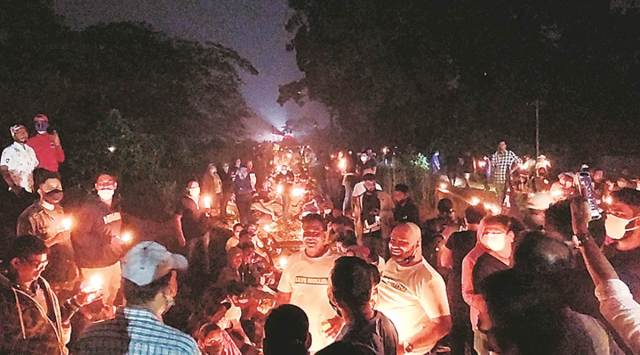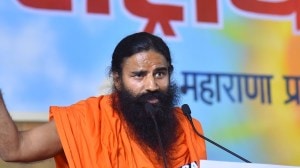- India
- International
Goans’ Night Protest Against Infra Projects: ‘This is not the land to destroy…we do not accept pollution’
Earlier this week, the South Western Railway started laying tracks at a village in Goa, leading to environmentalists groups calling the midnight protest.
 At the protest in Chandor. (Express Photo by Smita Nair)
At the protest in Chandor. (Express Photo by Smita Nair)By 10.30 pm, the Nossa Senhora De Belem church square in Chandor, Goa’s ancient capital, had a crowd of more than 3,000 — most had come to protest against the double-tracking of railway lines which Goans fear is towards expansion of coal imports from Mormugao Port Trust to Karnataka.
A man said on the speaker, “If this is the pandemic, the urgency is to stand here to safeguard the future from a bigger pandemic.”
Earlier this week, the South Western Railway started laying tracks at a village in Goa, leading to environmentalists groups calling the midnight protest.
By 11.30 pm, the crowd began its silent march towards the railway tracks off Chandor.
Sandra D’Sa, a Phd scholar, had her candle wrapped in a rosary. “The message was to occupy the tracks from midnight to 5 am. I am here, and hope my prayers hold me through the night.”

The crowd, mostly comprising youth and those who insisted to be called “villagers”, had a disagreement with political groups, asking them to lower party flags.
By midnight, the crowd further swelled, families having put the leftover “muddoshi and sungta” — fish dishes — “back in the fridge” and now spread on both sides of the tracks.
“This crowd is not a vote bank. This is history being made. We do not want our elected MLAs to speak for us. We are enough,” said Arvind Menezes from Aldona, as he walked on the tracks.
Piedade Vaz’s eyes looked silent, over his mask, as he held the candle. “This is not the land to destroy; we have a culture to protect, we do not accept pollution,” Vaz said, pointing to the multiple infrastructure projects at different stages of government clearance — the four-laning of NH4A, double-tracking of South Western Railway and a power line crawling through the western Ghats, and expansion of cargo jetties off the state’s two river banks.
By 1 am, the crowd had started to sing local Konkani songs. Elected MLas from the Opposition tried to make a speech but were quickly packed off.
Constancio Fernandes, 45, a sailor from Loutolim, had his arms on his friend’s shoulder as they stood on the tracks. “Forty MLAs sit inside the Assembly and not once have they discussed our issues.”
His friend Jimmy Rodriques nodded. “The government has to listen. This night has to be the loudest. You see, let’s say our sentiments matter too.” he said. “Policy can never be against the people. Assembly cannot be for corporates, it’s for the people.”
A little ahead, Vienna Fernandes, 62, the matron from a 500- year-old heritage home, is standing with a helmet on her head. “This coal directly affects me. The pollution has spoilt our living. I didn’t ask to stand here. I am forced to come out,” she said. “They tell us these corporates are big. Then they do not know us, we are from Salcette in Goa. There is a reason they call us the fighting redde (fighting bulls). Besides, there is a sense of brotherhood in Goa, we fight together.”
Protesting to protect environment
Mormugao Port Trust’s projections for 2030 say they want to import 51.6 million tonnes of coal for Adani Group, JSW Group and Vedanta. Much of this will be transported through Goa to other states. Also, Shipping Ministry has identified 17 coal-backed power plants and 22 steel plants as “potential clients” for the port. The protests are against infrastructure projects being designed to carry this coal that is expected to destroy ecological biodiversity. Railways haven’t got permissions for laying tracks in western Ghats and has started laying them in the state, which is when the Goans protested.
By then, slogans of “Go Back Adani” and “Go Back Jindal” are being raised and some have started performing the traditional Kunbi “dancing protest” by the side; teenagers are recording their views and going live on Instagram. A boy goes from person to person recording their views in social media, “we might as well do it ourselves, since no media is taking our voice across” he says as he records few old women sitting on the track. “I am relying on hashtags tonight to make people sit up” he says.
Christabelle Gomes, 22, stood with her friends. “I want to sit home and study. But so much disturbing information on social media that we are going to lose our biodiversity makes me angry. The government thinks we are foolish. I want to stand here. They need to take my consent, our consent.” When asked if she is scared of catching the virus, she replies, “I am not scared of the virus, I am scared of Coal. Why else will I be out at midnight by a railway track?”
By 1.30 am, the deputy collector, Jyoti Kumari, reached the site and appealed to the crowd to return. She said there is no permission for the protest. Her appeals that the crowd’s demand that no train “will cross today…has been accepted” was drowned with the loud crowd responding, “Never. Say they will cross never”. Abhijeet Prabhudesai, environmentalist representing Goyant Kollso Naka, asked her to give the order in writing and “to keep the project in abeyance”.
Till 5 am, no one budged from the spot. The protesters have now said they want the collector to stop giving clearance to laying of tracks.
Freddy Travasso, 47 recalled a meeting in June when ten concerned citizens had first decided to oppose the coal tracks and reach out to panchayats. He said, in a way, the night is also a hat tip to the times when Goa had agitated against Konkan Railways. “Today the crowd is much more aware, and fighting on equal footing. They teach in schools, protect hills, protect rivers. We are now using that textbook knowledge to use this night. Don’t call us protestors. We are lovers of Goa.” Travossa said the “movement” will now expand and will have to be “consistent as the coal trucks and trains on the tracks. Today we have supporters of Goyant Kollso Naka and Goencho Ekvott public groups assembled. Soon we hope more join”.
On the tracks was also Xavier Costa, 80 and his friend Francisco Fernandes, 69, both grandfathers. “We will be here till the last man leaves. Else, what face will I show to my grandchildren. They will ask me, why were you silent. I am willing to face this night, to avoid that day,” says Costa. He speaks of the strength of the movement as he points that traditional rivals of Salcette, “even people from Bardez (Taluka in north Goa) are here to speak against double tracking in south Goa.”
Fernandes added, “Now we feel we can pull this together. I told my family, either the Chief Minister or the God — one of them has to watch this night and make a good decision.”
By 3 am, the crowd was asking the deputy collector to respond in English as her responses are in Hindi. “We are Goans — speak English or Konkani,” the crowd repeated.
No outcome was at sight. Francisco Pacheco, 57, was standing with his hands folded. “I am here as my neighbour and his family in Chandor are affected. During the day, their workers also trespassed their excavators into Church property. They are going the wrong way about this. We have been patient for long,” he said. Every time the deputy collector asked for the “leader in the crowd”, the crowd responded, “Everyone is a leader here. Talk to us all.” This went on for two hours.
As dawn broke, Prabhudesai said, “We have followed all due process and given copies and appeals and representations to all MLAs, government offices. At this hour, if they come and tell us that we cannot do this, we only want to say, that this is history being written. We are being forced to use our Constitutional duty as well in ensuring no illegal work takes place. There is no communication of the facts on the ground from the state government to the central government. We decided to speak for ourselves.”
Till the early hours of dawn, a portable speaker playing Goan numbers moved from one end of the track to the other to ensure that the night was kept alive. Thousands of candles sat melted on the tracks having captured a “historic night”.
Also Read: From our Express Investigation in 2017
Coal on move, 25 tonnes a minute, is choking Goa, more is on the way
Coal Burying Goa: What the toxic train leaves in its wake
Coal Burying Goa: All along the road route, the black dust settles
Coal burying Goa: Danger ahead, new coal corridor is coming up
Coal Burying Goa: Lives touched by coal
Coal burying Goa: Cleaning Goa, the legal fight so far
Coal burying Goa: After road and rail, river at risk as coal floats by
Buzzing Now
Apr 16: Latest News
- 01
- 02
- 03
- 04
- 05






































